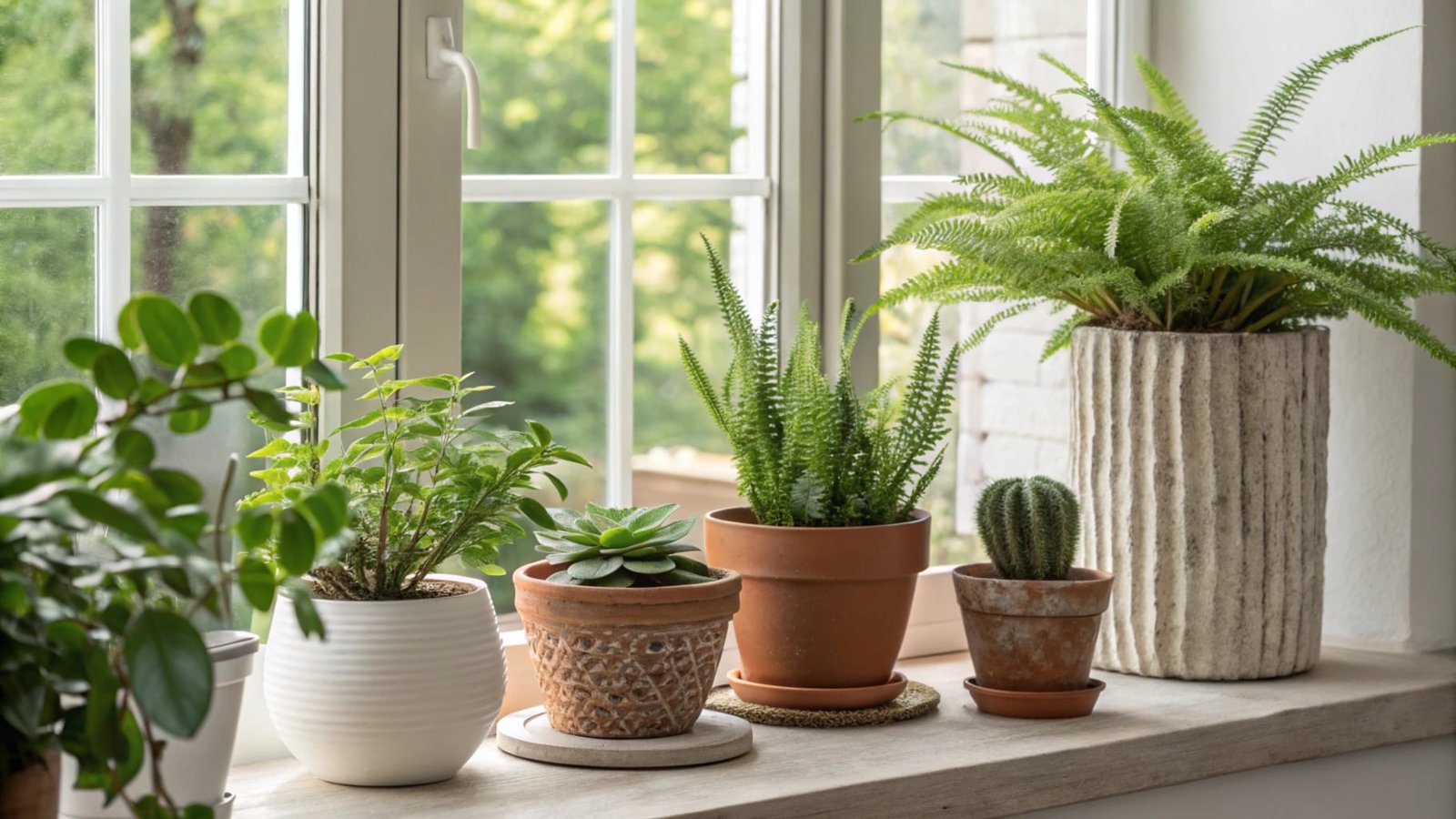
Indoor plants need the right pot to thrive. Choosing the best type can make all the difference in their health and growth.
When selecting a pot for indoor plants, consider factors like material, drainage, size, and style. The right choice can improve plant vitality.
Choosing the right pot for your indoor plants is crucial for their overall health. Keep reading to find out which factors make the biggest impact on plant growth and care.
What material is best for indoor plant pots?
Choosing the right material is the first step in finding a good pot for your indoor plants. Different materials offer varying degrees of breathability, moisture retention, and aesthetics. Some materials are better for certain types of plants, while others may not be suitable for more sensitive species.
The best material depends on your plant type and environment. Clay, plastic, and ceramic are common options, each with pros and cons.
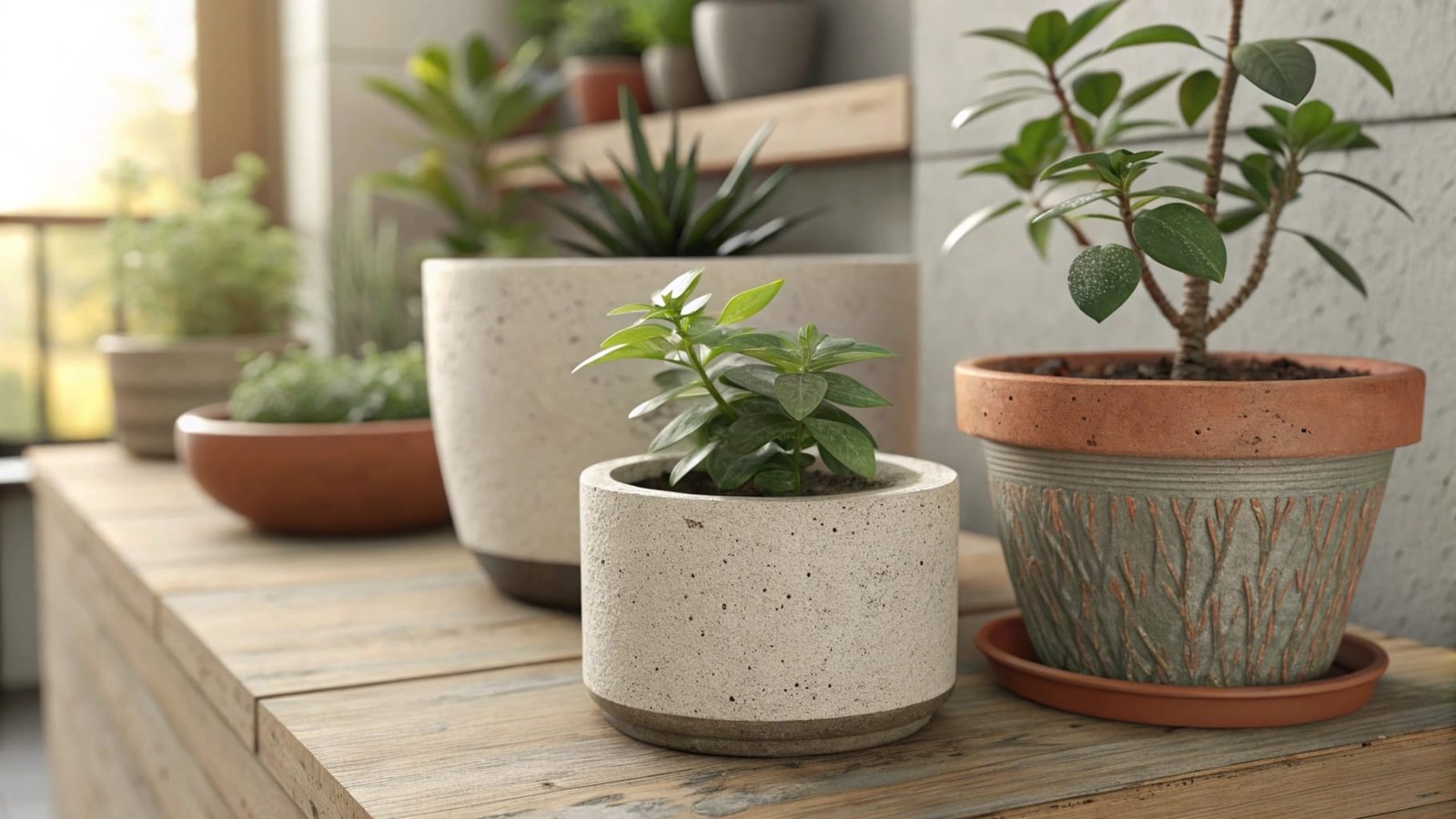
Clay Pots
Clay pots are a traditional favorite for many indoor plants. Made from terracotta, they are porous and allow for air and moisture movement. This is beneficial for plants that don’t like to stay too moist, such as succulents and cacti. The breathable nature of clay helps keep the roots healthy by allowing air to circulate around them.
Advantages:
- Porous nature lets air reach the roots, preventing root rot
- Provides good drainage
- Suitable for drought-tolerant plants like succulents and cacti
- Adds a rustic and natural aesthetic to your indoor garden
Disadvantages:
- Prone to cracking in cold weather if not properly handled
- Can dry out plants faster than plastic, requiring more frequent watering
- Heavy, making them harder to move around
Plastic Pots
Plastic pots are lightweight, affordable, and often come in a wide variety of shapes and sizes. While they don’t offer the same breathability as clay pots, they are still a popular choice for indoor plants due to their water retention properties. This makes them especially suitable for plants that need to be kept consistently moist.
Advantages:
- Affordable and widely available
- Retains moisture better than clay, reducing the frequency of watering
- Lightweight and easy to handle, making them suitable for larger plants
- Less likely to crack or break compared to clay
Disadvantages:
- Can cause root rot if not properly drained, especially in large pots
- Less breathable than clay, potentially leading to root issues like oxygen deprivation
- Aesthetically less appealing compared to other materials like ceramic
Ceramic Pots
Ceramic pots are often glazed, giving them a shiny, colorful look. While they offer some of the same benefits as clay, the glaze reduces the pot’s breathability. They are a great option for ornamental plants that don’t require too much moisture regulation. Ceramic pots tend to be more decorative and can add a modern or vintage touch to any room.
Advantages:
- Aesthetic appeal with a variety of designs and colors
- Heavy and sturdy, preventing toppling or tipping over of tall plants
- Retains moisture longer than clay, reducing the risk of drying out quickly
Disadvantages:
- Heavier than plastic, making them harder to move
- Reduced breathability due to the glaze
- Typically more expensive than other materials like plastic or clay
Choosing the Best Material for Your Plant
When selecting a material for your indoor plant pot, it’s important to think about your plant’s needs. For example, if you are growing a succulent, a porous material like clay is ideal, as it allows excess moisture to evaporate, preventing root rot. For plants that require more moisture, such as ferns or tropical species, plastic or glazed ceramic might be better choices, as they retain moisture for longer periods. Consider your environment as well—clay pots may crack in colder conditions, while plastic ones are more durable.
Additionally, consider the overall aesthetic of your space. While plastic pots are highly functional and often come in various colors and sizes, some plants benefit from the earthy, rustic look of clay or ceramic pots. The material of the pot can add to the ambiance of your indoor garden, complementing your home’s style.
Should I choose a pot with drainage holes or without?
A key decision when selecting a pot is whether to choose one with drainage holes. These small openings are often overlooked but can have a big impact on the health of your plants. Without proper drainage, water can accumulate at the bottom of the pot, leading to root rot and other issues.
Drainage holes are essential for most indoor plants to prevent overwatering and root rot. However, there are exceptions based on plant needs.
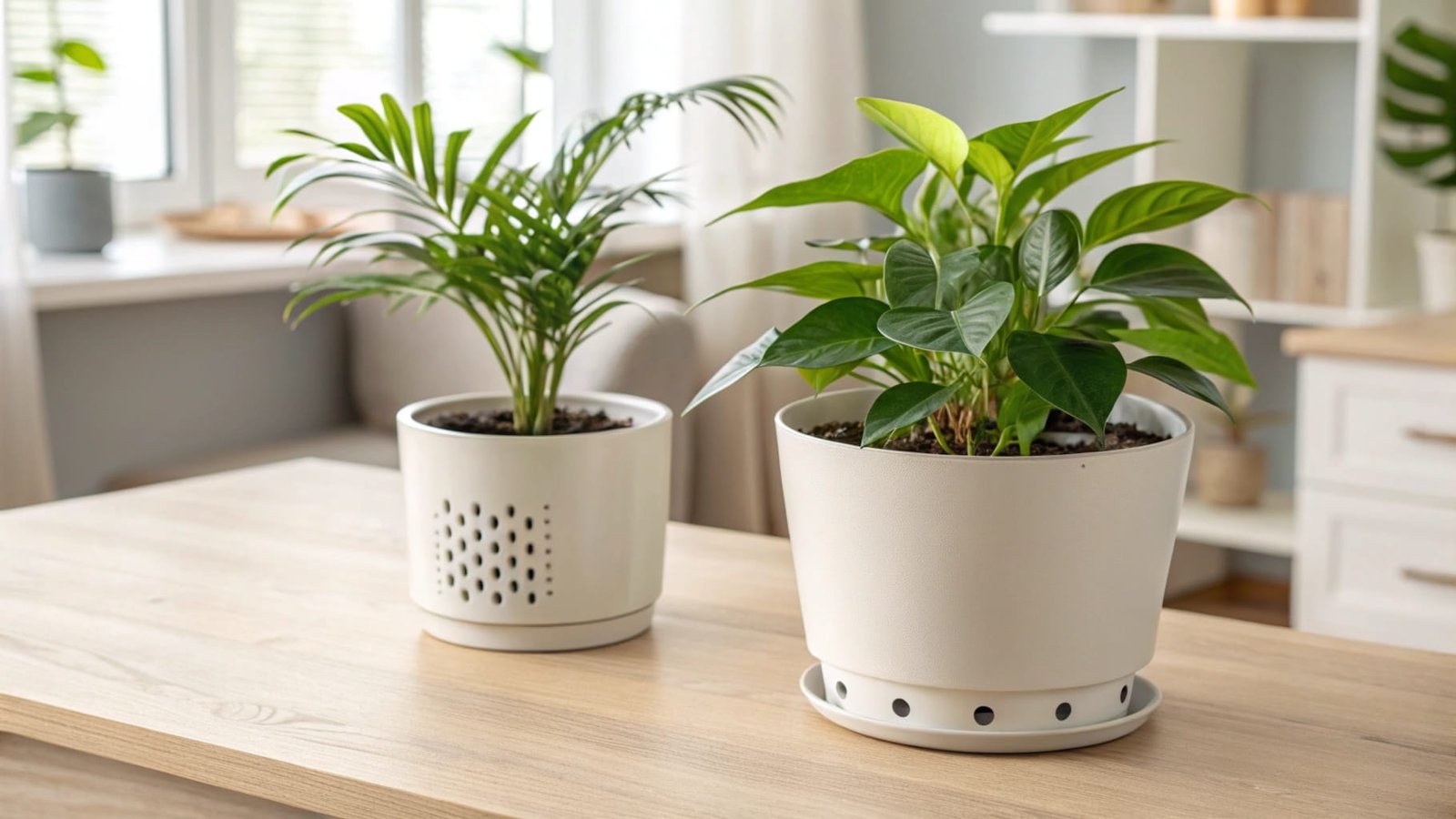
The Importance of Drainage
Drainage holes are necessary because they allow excess water to escape. Without them, water can accumulate at the bottom of the pot, leading to root rot and poor plant health. It’s important to understand that overwatering is one of the most common causes of plant stress, so ensuring proper drainage can significantly increase your chances of maintaining healthy plants.
Benefits of Drainage Holes:
- Prevents water buildup, which can lead to root rot
- Helps oxygen reach the roots, encouraging healthy growth
- Allows excess water to flow freely, preventing soggy soil and waterlogged roots
When to Avoid Drainage Holes
Some plants, particularly those that thrive in wetter conditions, like peace lilies, water-loving ferns, and certain types of orchids, can sometimes do well without drainage holes. These plants enjoy sitting in moist conditions, and their roots don’t mind soaking up the water. However, even in these cases, it’s important to monitor water levels carefully. For example, you can use a shallow tray to collect excess water or allow the soil to dry out slightly between waterings.
Options for Pots Without Drainage:
- Use a liner or double potting system, where a smaller pot with drainage is placed inside a decorative pot without drainage
- Opt for self-watering pots, which allow for controlled moisture levels
- Be cautious of overwatering—make sure the plant’s roots don’t sit in water for extended periods
How to Deal with Drainage in Decorative Pots
Sometimes, decorative pots are designed without drainage holes for aesthetic purposes. In such cases, you can still use them by adding a layer of rocks or gravel at the bottom to help with water movement. Alternatively, you can use a double potting system, where a plastic pot with drainage fits inside the decorative one. Another strategy is to keep a close eye on the moisture level in your soil and ensure it doesn’t become waterlogged, which is a common problem with pots that lack drainage. Consider adding a layer of charcoal or activated carbon to the bottom of the pot to absorb excess moisture and prevent mold or fungal growth.
How does the size of the pot affect plant growth?
The size of your pot has a direct impact on how well your plant will grow. A pot that is too small or too large can negatively affect root development, drainage, and overall plant health. It’s essential to choose the right size to ensure your plant thrives.
Choosing the right size pot is crucial for ensuring proper root growth and water retention.
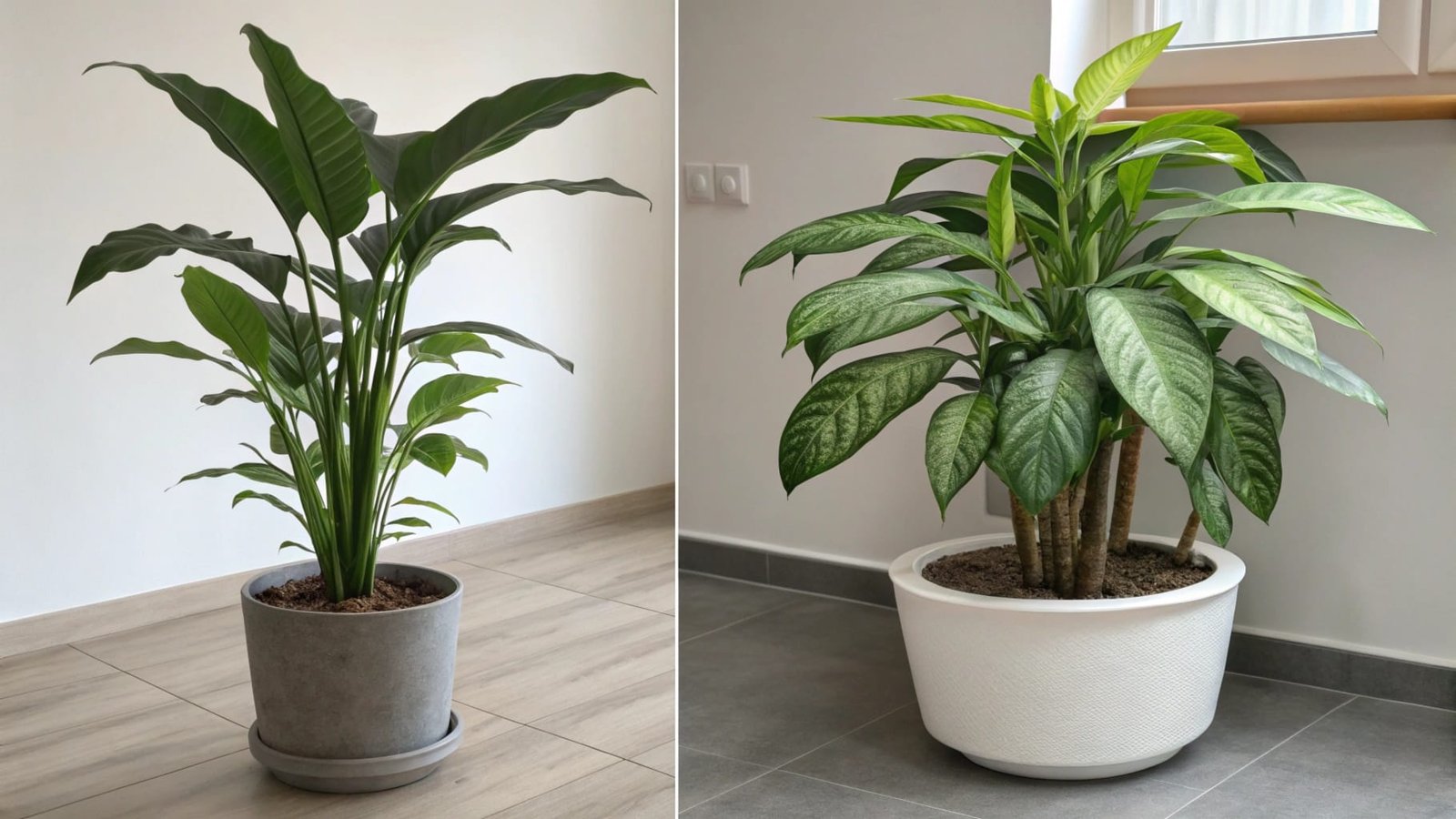
Pot Too Small: A Struggle for Growth
If the pot is too small, your plant’s roots won’t have enough space to grow and spread out. This can stunt the plant’s growth and cause it to become root-bound, where the roots circle the inside of the pot rather than growing outward. A root-bound plant will often show signs of stress, such as yellowing leaves, drooping stems, or slowed growth. Smaller pots also have limited soil, which can dry out more quickly, requiring more frequent watering.
Symptoms of Root-Bound Plants:
- Slower growth or stunted leaves
- Yellowing leaves and weak stems
- Dry or wilted foliage due to rapid drying out of the soil
Pot Too Large: The Risk of Overwatering
While a pot that’s too small can limit growth, a pot that’s too large can create problems as well. Excess soil means that water will take longer to drain, increasing the risk of overwatering. Additionally, large pots can lead to root rot if the plant’s root system isn’t established enough to absorb all the water. Larger pots also tend to have a greater capacity for moisture, meaning that water may sit around the roots longer than it should, which leads to stagnant conditions that favor the growth of mold and fungi.
Symptoms of Overwatering:
- Wilting leaves despite having enough water
- Root rot (smelly or discolored roots)
- Mold or algae growth due to excessive moisture in the soil
Finding the Right Size
A good rule of thumb is to choose a pot that is 1-2 inches larger in diameter than the plant’s current root ball. This allows for growth while ensuring proper drainage and moisture balance. For most plants, this size will provide ample space for root expansion without the risk of excessive moisture retention. When re-potting a plant, it’s important to avoid choosing a pot that is too deep for the plant’s roots. The depth of the pot should match the root system’s needs, especially for plants that have shallow roots, such as many herbs.
Are self-watering pots a good choice for indoor plants?
Self-watering pots have become increasingly popular among indoor gardeners. These pots feature a reservoir that allows the plant to take up water as needed, reducing the risk of over or underwatering.
Self-watering pots can be convenient for busy plant owners, but they may not be right for every type of plant.

How Self-Watering Pots Work
Self-watering pots typically have a water reservoir at the bottom. A wick system or capillary action draws the water up into the soil, keeping it evenly moist without the need for constant watering. This system can be beneficial for plants that require consistent moisture levels, such as herbs, vegetables, or moisture-loving houseplants like peace lilies.
Advantages of Self-Watering Pots:
- Reduces frequency of watering
- Helps prevent overwatering or underwatering
- Consistent moisture level for plants, reducing the risk of stress
Disadvantages and Considerations
While convenient, self-watering pots can also present challenges. For instance, they may not provide sufficient drainage, which can lead to root rot in some plants. Additionally, they are generally better suited to plants that prefer consistent moisture, such as herbs or leafy greens. If used with a plant that prefers drier conditions, the system can cause issues with overwatering, as the plant might become waterlogged.
Drawbacks:
- Limited drainage options
- Not ideal for plants that prefer drier conditions, such as succulents
- Risk of waterlogging if improperly maintained or left unchecked
Are They Right for You?
Self-watering pots are a great choice for those who travel often or struggle to remember regular watering. However, they may not be suitable for all plant types, so it’s important to consider your plant’s specific watering needs before choosing this type of pot. For example, succulents and cacti, which require less water, might not do well in a self-watering pot. On the other hand, plants that like consistent moisture levels, such as ferns and pothos, may benefit from the regular hydration provided by self-watering pots.
What are the advantages of decorative pots for indoor plants?
While functionality is key, many plant owners also enjoy incorporating aesthetic elements into their plant care. Decorative pots can elevate the look of your indoor space and complement your home’s style. However, they should still allow for proper drainage and growth.
Decorative pots offer both visual appeal and functionality, but they should not compromise the health of your plants.
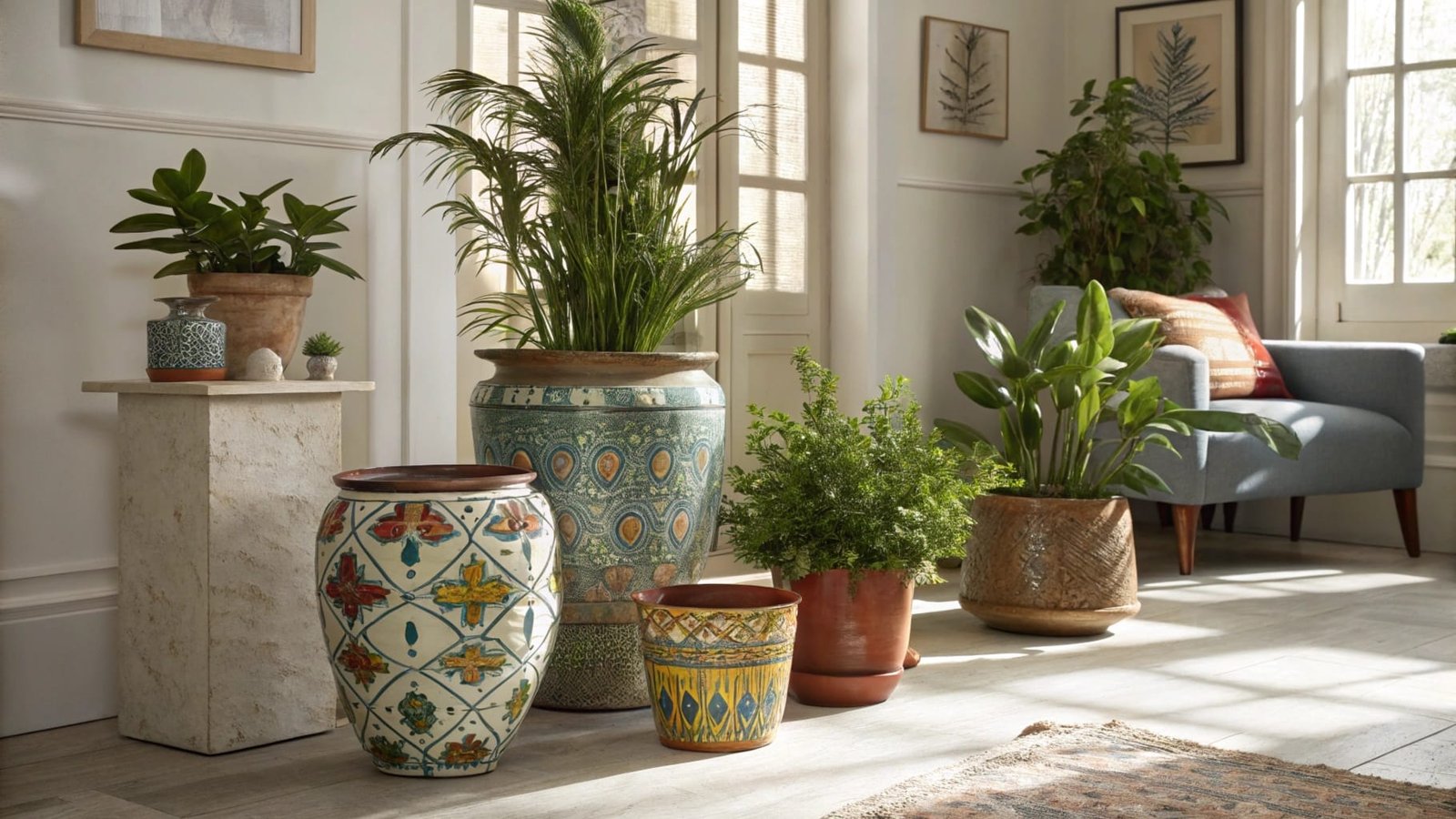
Aesthetic Appeal
Decorative pots come in various designs, colors, and materials, allowing you to express your personal style while caring for your plants. These pots can range from minimalist modern designs to ornate vintage styles. The right pot can blend seamlessly with your home décor or stand out as a focal point in any room.
Benefits of Decorative Pots:
- Enhances the visual appeal of your home and indoor space
- Complements various interior design themes, from contemporary to bohemian
- Can be a personal expression of your style, adding character to your indoor garden
Functionality Considerations
While decorative pots are appealing, they can sometimes lack important features like drainage holes. In some cases, decorative pots may also be too small or not suited to the plant's root system. It’s essential to balance form with function. When purchasing decorative pots, always check whether they provide adequate space for your plant’s roots, as well as proper drainage.
Keeping Your Plants Healthy:
- Choose pots with drainage or use a double potting system
- Consider the material for moisture regulation
- Don’t sacrifice plant health for aesthetics
The Best of Both Worlds
You don’t have to choose between style and functionality. Look for decorative pots that offer a balance of aesthetics and practicality, such as those made of ceramic or lightweight plastic with built-in drainage. For a more personalized touch, you can even paint or decorate plain pots to suit your home’s interior.
Conclusion
Choosing the right pot for your indoor plants is essential for their growth and well-being. The material, size, drainage, and style all play crucial roles in helping your plants thrive. Consider your plant’s needs and your own preferences when selecting the perfect pot to ensure your indoor garden flourishes. Keep in mind that functionality should always come first, but there’s no harm in choosing a pot that reflects your personal style while supporting your plants' needs.


